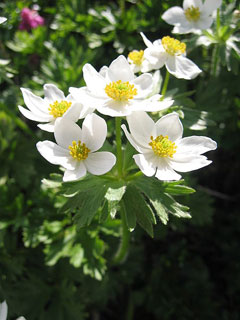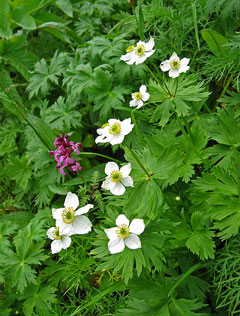 |
|
http://commons.wikimedia.org/wiki/User:S64 |
 |
| http://commons.wikimedia.org/wiki/User:S64 |
Translate this page:
Summary
Physical Characteristics

 Anemone_narcissiflora is a PERENNIAL growing to 0.6 m (2ft) by 0.5 m (1ft 8in).
Anemone_narcissiflora is a PERENNIAL growing to 0.6 m (2ft) by 0.5 m (1ft 8in).
See above for USDA hardiness. It is hardy to UK zone 3. It is in flower in May, and the seeds ripen from June to July. The species is hermaphrodite (has both male and female organs) and is pollinated by Bees, flies. The plant is self-fertile.
Suitable for: light (sandy), medium (loamy) and heavy (clay) soils and prefers well-drained soil. Suitable pH: mildly acid, neutral and basic (mildly alkaline) soils. It can grow in semi-shade (light woodland) or no shade. It prefers moist soil.
UK Hardiness Map
US Hardiness Map
Synonyms
Plant Habitats
Edible Uses
Leaves - raw or cooked[46, 61, 177]. The leaves , together with other salad greens and oil, were beaten to a creamy consistency and frozen into an 'ice cream'[257].Some caution is advised, see the notes above on toxicity. Root - raw[177]. The upper root ends have been used for food[257]. Some caution is advised, see the notes above on toxicity.
References More on Edible Uses
Medicinal Uses
Plants For A Future can not take any responsibility for any adverse effects from the use of plants. Always seek advice from a professional before using a plant medicinally.
The plant has been used as an antihaemorrhagic[270].
References More on Medicinal Uses
The Bookshop: Edible Plant Books
Our Latest books on Perennial Plants For Food Forests and Permaculture Gardens in paperback or digital formats.

Edible Tropical Plants
Food Forest Plants for Hotter Conditions: 250+ Plants For Tropical Food Forests & Permaculture Gardens.
More

Edible Temperate Plants
Plants for Your Food Forest: 500 Plants for Temperate Food Forests & Permaculture Gardens.
More

More Books
PFAF have eight books available in paperback and digital formats. Browse the shop for more information.
Shop Now
Other Uses
References More on Other Uses
Cultivation details
Succeeds in ordinary garden soil but prefers a rich sandy loam[1] and full sun[200]. Succeeds in full sun or part shade[187]. Plants succeed in maritime gardens[233]. Hardy to about -20°c[187]. Plants seem to be immune to the predations of rabbits[233]. A greedy plant, inhibiting the growth of nearby plants, especially legumes[54]. A very ornamental[1] and highly polymorphic plant[50, 187, 270]. There are a large number of sub-species[270].
References Carbon Farming Information and Carbon Sequestration Information
Temperature Converter
Type a value in the Celsius field to convert the value to Fahrenheit:
Fahrenheit:
The PFAF Bookshop
Plants For A Future have a number of books available in paperback and digital form. Book titles include Edible Plants, Edible Perennials, Edible Trees,Edible Shrubs, Woodland Gardening, and Temperate Food Forest Plants. Our new book is Food Forest Plants For Hotter Conditions (Tropical and Sub-Tropical).
Shop Now
Plant Propagation
Seed - best sown in a cold frame as soon as it is ripe in the summer[1]. Surface sow or only just cover the seed and keep the soil moist. Sow stored seed as soon as possible in late winter or early spring. The seed usually germinates in 1 - 6 months at 15°c[133]. When large enough to handle, prick the seedlings out into individual pots and grow them on in light shade in the greenhouse for at least their first year. When the plants are large enough, plant them out in the spring. Division in late summer after the plant dies down. This plant is very slow to increase[187].
Other Names
If available other names are mentioned here
Native Range
TEMPERATE ASIA: Afghanistan, Turkey (north), Russian Federation-Ciscaucasia (Ciscaucasia), Armenia, Azerbaijan, Georgia, Russian Federation (Dagestan), Russian Federation-Western Siberia (Western Siberia), Russian Federation-Eastern Siberia (Eastern Siberia), Kazakhstan, Kyrgyzstan, Tajikistan, Mongolia, Russian Federation (Habarovskij kraj, Primorye, Amur, Kamcatskij kraj, Sakhalin), China (Hebei Sheng (north), Yunnan Sheng (west), Nei Mongol Zizhiqu (west), Ningxia Huizi Zizhiqu (northwest), Xinjiang Uygur Zizhiqu), Japan (Hokkaidô, Honshu (north & central)), Korea, North NORTHERN AMERICA: Canada (Northwest Territories (west), Yukon, British Columbia (north)), United States (Alaska, Colorado (west), Wyoming (northeast)) EUROPE: Austria, Switzerland, Czech Republic, Germany, Poland (south), Slovakia, Russian Federation-European part (European part (east)), Belarus, Ukraine (west), Albania, Bulgaria, Bosnia and Herzegovina, Croatia, Italy, North Macedonia, Montenegro, Romania, Serbia, Slovenia, Spain, France
Weed Potential
Right plant wrong place. We are currently updating this section.
Please note that a plant may be invasive in one area but may not in your area so it’s worth checking.
Conservation Status
IUCN Red List of Threatened Plants Status :

Growth: S = slow M = medium F = fast. Soil: L = light (sandy) M = medium H = heavy (clay). pH: A = acid N = neutral B = basic (alkaline). Shade: F = full shade S = semi-shade N = no shade. Moisture: D = dry M = Moist We = wet Wa = water.
Expert comment
Author
L.
Botanical References
50200270
Links / References
For a list of references used on this page please go here
Readers comment
| Add a comment |
|
If you have important information about this plant that may help other users please add a comment or link below. Only comments or links that are felt to be directly relevant to a plant will be included. If you think a comment/link or information contained on this page is inaccurate or misleading we would welcome your feedback at [email protected]. If you have questions about a plant please use the Forum on this website as we do not have the resources to answer questions ourselves.
* Please note: the comments by website users are not necessarily those held by PFAF and may give misleading or inaccurate information.
To leave a comment please Register or login here All comments need to be approved so will not appear immediately.
|
Subject : Anemone_narcissiflora
|
|
|
|